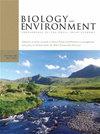地质真菌学:真菌作为生物地球化学变化的媒介
IF 0.6
4区 环境科学与生态学
Q4 ENVIRONMENTAL SCIENCES
Biology and Environment-Proceedings of the Royal Irish Academy
Pub Date : 2022-01-01
DOI:10.1353/bae.2013.0006
引用次数: 2
摘要
摘要:地质真菌学是研究真菌在地质过程中的作用的学科。真菌在营养和元素循环、岩石、矿物和金属转化、生物风化和真菌源生物矿物形成等几个领域具有重要的生物地球化学意义。这种过程可以发生在水生和陆地栖息地,但真菌可能具有最大的地球化学影响的陆地环境。特别重要的是与光养生物的共生关系:地衣(藻类,蓝藻)和菌根(植物)。许多地质真菌过程的核心是金属和矿物的转化,真菌具有许多特性,影响金属形态、毒性和流动性的变化,以及矿物的形成或溶解或变质。一些真菌转化在环境生物技术中有潜在的应用,例如金属和放射性核素的浸出、回收、解毒和生物修复,以及具有催化或其他性质的生物矿物或金属元素的生产或沉积。金属和矿物转变也可能产生不利影响,当这些过程导致天然和合成材料、岩石和矿物基建筑材料(如混凝土)的破坏和破坏,金属、合金和有关物质的生物腐蚀,以及对放射性核素形态、流动性和密封产生不利影响时。本文章由计算机程序翻译,如有差异,请以英文原文为准。
PRAEGER REVIEW: GEOMYCOLOGY: FUNGI AS AGENTS OF BIOGEOCHEMICAL CHANGE
Abstract:Geomycology is the study of the roles of fungi in geological processes. The biogeochemical importance of fungi is significant in several areas, including nutrient and element cycling, rock, mineral and metal transformations, bioweathering and mycogenic biomineral formation. Such processes can occur in aquatic and terrestrial habitats, but it is the terrestrial environment where fungi probably have the greatest geochemical influence. Of special significance are the mutualistic relationships with phototrophic organisms: lichens (algae, cyanobacteria) and mycorrhizas (plants). Central to many geomycological processes are transformations of metals and minerals, and fungi possess many properties that effect changes in metal speciation, toxicity and mobility, as well as mineral formation or mineral dissolution or deterioration. Some fungal transformations have potential applications in environmental biotechnology, e.g. metal and radionuclide leaching, recovery, detoxification and bioremediation, and in the production or deposition of biominerals or metallic elements with catalytic or other properties. Metal and mineral transformations may also result in adverse effects when these processes result in spoilage and destruction of natural and synthetic materials, rock and mineral-based building materials (e.g. concrete), biocorrosion of metals, alloys and related substances, and adverse effects on radionuclide speciation, mobility and containment.
求助全文
通过发布文献求助,成功后即可免费获取论文全文。
去求助
来源期刊
CiteScore
1.10
自引率
0.00%
发文量
6
审稿时长
>36 weeks
期刊介绍:
The journal aims to offer a broad coverage of the subject area, including the following:
- biology and ecology of the Irish flora and fauna
- microbial ecology
- animal, plant and environmental physiology
- global change
- palaeoecology and palaeoclimatology
- population biology; conservation of genetic resources
- pollution and environmental quality; ecotoxicology
- environmental management
- hydrology
- land use, agriculture, soils and environment.
Submissions on other relevant topics are also welcome, and papers of a cross-disciplinary nature are particularly encouraged.

 求助内容:
求助内容: 应助结果提醒方式:
应助结果提醒方式:


